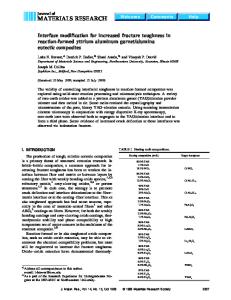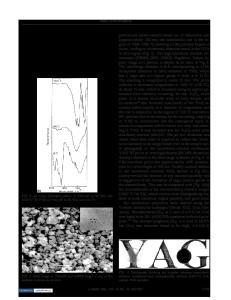Evolution of Yttrium Aluminum Garnet Films by Solid-State Reaction
- PDF / 2,754,697 Bytes
- 6 Pages / 414.72 x 648 pts Page_size
- 13 Downloads / 351 Views
JASON R. HEFFELFINGER AND C. BARRY CARTER Department of Chemical Engineering and Materials Science, University of Minnesota, 421 Washington Ave. S.E., Minneapolis, MN 55455
ABSTRACT Yttrium aluminum garnet (YAG) films were produced by reacting thin Y20 3 layers with single-crystal A120 3 substrates. Y20 3 films were deposited using pulsed-laser deposition (PLD), which produced smooth textured films on specially prepared (0001) a-A1203 substrates. Solidstate reaction of the Y203 with the A12 0 3 was induced by specific heat treatments. Transmission-electron microscopy was used to characterize the reaction products of each heat treatment. For a reaction temperature of 1200'C, cross-sectional TEM specimens revealed the development of monoclinic Y4A12 0 9 at the interface between the Y 2 0 3 and the A12 03. Development of YAG was seen to occur at the interface between the A12 03 and the Y4 A120 9 for a slightly higher reaction temperature of 1250°C. The metastable Y4A12 0 9 phase and the Y203 phase were found to be consumed at higher reaction temperatures to form the equilibrium Y 3 A15 0 1 2 (YAG) phase. The morphology of the YAG film was characterized by scanning-electron microscopy. INTRODUCTION The reaction of Y2 0 3 with A12 0 3 is seen in many technologically relevant systems. For example, this reaction is seen in the production of YAG which is used as a host material for lasing media and as an optical material. In a quite different application, Y20 3 is used as a sintering aid and an oxygen getter in AIN. Y 2 0 3 reacts with oxygen impurities in AIN to form YAG inclusions. The formation of multi-component oxides in the Y20 3 -AI20 3 system has been studied for the bulk reaction of mixed oxide powders, but no research as to date has looked at thin-film phase development.1"2 Previous research has suggest that thin-film phase formations are controlled by mass transport across phase boundaries. 3 Kinetics of such mass transportation are not well understood. The phase diagram for the Y 2 0 3 -AI 2 0 3 system shows Y4 AI 2 0 9 and Y3 AI5 OI2 as intermediate phases. 4 Such a diagram can predict the development of equilibrium phases but gives no information about the kinetics of the system. In this study, a reaction geometry of a thin-film on a single crystal was used to study initial phase development. This reaction geometry has been used previously to study the formation of spinel in the reaction between NiO and single-crystal A12 0 3 .5The present work establishes a well characterized initial state by observation of the as-deposited Y20 3 film in cross-section TEM. The evolution of the multi-component oxides in the Y20 3 -AI2 0 3 system has been characterized for specific heat treatments by cross-sectional TEM observation. EXPERIMENTAL Substrate and Target Preparation Thin films of Y 20 3 were grown by PLD onto specially prepared single-crystal (0001) a-A12 0 3 substrates. The substrates were cut from bulk A12 0 3 into 2.1 mm squares using a Isomet diamond saw. Prior to thin-film deposition all substrates were acid
Data Loading...











